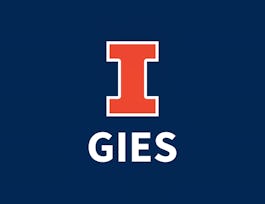This short course surveys all the major topics covered in a full semester MBA level finance course, but with a more intuitive approach on a very high conceptual level. The goal here is give you a roadmap and framework for how financial professional make decisions.


Finance for Non-Finance Professionals
Taught in English
Some content may not be translated
173,016 already enrolled
(2,613 reviews)
Skills you'll gain
Details to know

Add to your LinkedIn profile
10 quizzes
See how employees at top companies are mastering in-demand skills


Earn a career certificate
Add this credential to your LinkedIn profile, resume, or CV
Share it on social media and in your performance review

There are 5 modules in this course
Welcome to Finance for Non-Finance Professionals! In this section you will find general information about the course and instructions on how to navigate the course. For the first week of lectures, we will be covering the basics of financial valuation. We will start with the basics of compounding and discounting rates of return over time. Using these tools we will then move on to valuation using the discounted cash flow method. Along the way, we will demonstrate our valuation tools with a variety of practical examples and compare our analysis with other valuation techniques.
What's included
15 videos3 readings2 quizzes1 discussion prompt
Welcome to the second week of Finance for Non-Finance Professionals! In this week of the course, we will build on the basic valuation tools from week one to start making capital budgeting decisions. Our capital budgeting review covers the basic tools like Net Present Value, Internal Rate of Return, Payback period, and return on capital. Our discussion of the relative advantages of each different tool leads us into sensitivity analysis and the advantages of spreadsheet modeling.
What's included
11 videos1 reading2 quizzes
Welcome back to Finance for Non-Finance Professionals! In our third week together, we will go on a treasure hunt through the financial statements. Using discounted cash flows as our motivation, we search through the income statement and balance sheet for all the uses and sources of cash. Our search leads us to our primary measure of value creation: Free Cash Flow. Free cash flow will form the basis of most financial analysis and this module gives us a roadmap for estimating and forecasting cash creation within any organization.
What's included
10 videos1 reading2 quizzes
Welcome back everyone! In our final week together in this course, we switch gears and take an external view of the firm from a Wall Street, or capital markets, perspective. We think about the basic tradeoff between risk and return, how to measure risk, and how to put a risk premium on different kinds of investments. We then take our analysis of risk and return and use it to estimate a firm's cost of capital. Finally, we circle back to free cash flows, capital budgeting and valuation to tie together all four weeks and get ready for our capstone case analysis.
What's included
10 videos2 readings2 quizzes
In this final part of the course we bring all of our analysis to bear on a realistic case study. We will evaluate the investment prospects of Sunrise Bakery. As their CFO considers a large capital expenditure, she needs to think about the tradeoff between spending money today and generating more free cash flow in the future. Our job in this case is to forecast the amount of cash generation the new equipment will produce, discount the cash flows, and use all of our capital budgeting tools to make a sound financial recommendation.
What's included
1 video3 readings2 quizzes
Instructor

Offered by
Recommended if you're interested in Finance

Rice University

Emory University

University of Illinois at Urbana-Champaign

University of California, Irvine
Why people choose Coursera for their career




Learner reviews
Showing 3 of 2613
2,613 reviews
- 5 stars
82.12%
- 4 stars
15.46%
- 3 stars
1.37%
- 2 stars
0.34%
- 1 star
0.68%
New to Finance? Start here.

Open new doors with Coursera Plus
Unlimited access to 7,000+ world-class courses, hands-on projects, and job-ready certificate programs - all included in your subscription
Advance your career with an online degree
Earn a degree from world-class universities - 100% online
Join over 3,400 global companies that choose Coursera for Business
Upskill your employees to excel in the digital economy
Frequently asked questions
Access to lectures and assignments depends on your type of enrollment. If you take a course in audit mode, you will be able to see most course materials for free. To access graded assignments and to earn a Certificate, you will need to purchase the Certificate experience, during or after your audit. If you don't see the audit option:
The course may not offer an audit option. You can try a Free Trial instead, or apply for Financial Aid.
The course may offer 'Full Course, No Certificate' instead. This option lets you see all course materials, submit required assessments, and get a final grade. This also means that you will not be able to purchase a Certificate experience.
When you purchase a Certificate you get access to all course materials, including graded assignments. Upon completing the course, your electronic Certificate will be added to your Accomplishments page - from there, you can print your Certificate or add it to your LinkedIn profile. If you only want to read and view the course content, you can audit the course for free.
You will be eligible for a full refund until two weeks after your payment date, or (for courses that have just launched) until two weeks after the first session of the course begins, whichever is later. You cannot receive a refund once you’ve earned a Course Certificate, even if you complete the course within the two-week refund period. See our full refund policy.


